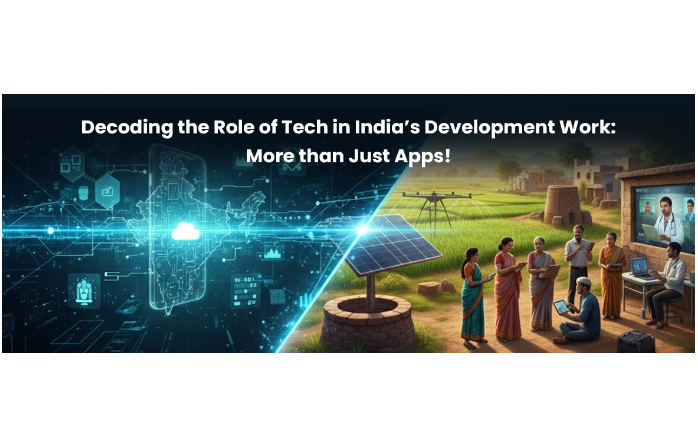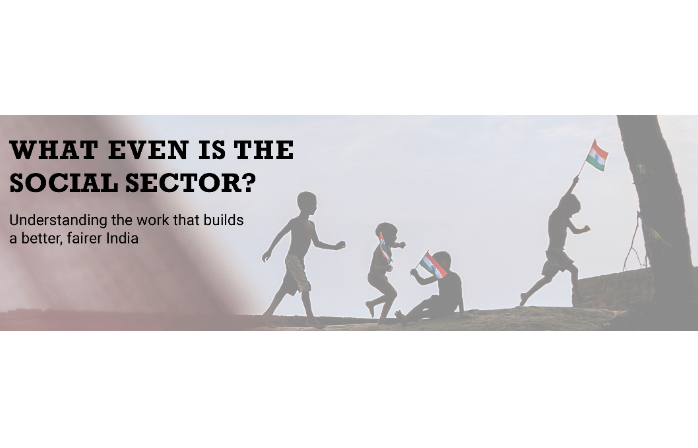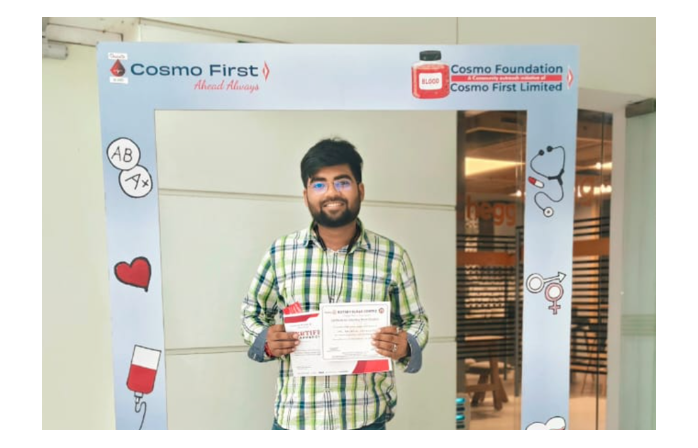Decoding the Role of Tech in India’s Development Work: More than Just Apps
By- Ritika Soun
September 15, 2025

NGOBOX
Introduction: Rethinking Tech’s Role
In development circles, conversations around technology often begin and end with a new app. From digital learning platforms to health-tracking dashboards, there is a tendency to reduce technology to something that fits neatly into a smartphone. Unfortunately, this limited perspective misses the bigger picture.
In a country as vast and complex as India, technology is not just a set of tools. It is an enabler, a force that, when purposefully and meaningfully integrated, reshapes how people access opportunity, health, education, and dignity.
This article aims to decode how technology functions in India’s development sector: not as a silver bullet, but as part of a deeper, more human-centered transformation. The spotlight must shift from apps to ecosystems; from platforms to people.
Beyond Apps: Defining Technology in Development
Early tech-for-good efforts often centered on creating apps to ‘fix’ problems, to track attendance, deliver advice, and digitize surveys. While apps may offer short-term fixes, sustainable impact comes from embedding technology within deeper socio-economic systems. Over time, practitioners have learned that technology only works when embedded in a broader social, cultural, and economic system.
New India’s development landscape is now seeing a more thoughtful wave of tech adoption, one that emphasizes contextual design, open-source platforms, and community participation. These solutions are grounded in the real needs of communities and frontline workers, not just digital convenience.
Even Nobel laureate Amartya Sen’s Capability Approach reminds us that real development enhances people’s ability to live the lives they value. Technology, therefore, must support capabilities, and not replace agency. With this understanding, let’s explore how technology is being meaningfully integrated across key sectors.
Agriculture: How Precision Tech Empowers Farmers
In rural India, the shift to digital agriculture has created new possibilities for smallholder farmers. Tools like Fasal and AgroStar use IoT sensors, AI, and data analytics to help farmers make informed decisions about irrigation, pesticide use, and weather risks.
At the other end of the spectrum lies Nano Ganesh, a frugal innovation that allows farmers to switch water pumps on and off using basic mobile phones, saving time and labor, especially for women.
Both high-tech and low-tech innovations can drive change when designed with and for the end user. Similarly, in healthcare, digital tools are amplifying and not replacing human capacities on the frontlines.
Healthcare: Synergy Between People and Platforms
In tribal districts like Rayagada, Odisha, AI-powered maternal and child health kits now assist ASHA workers in diagnosing high-risk pregnancies. This reflects a key truth: technology doesn’t replace the frontline workers, it strengthens their ability to respond effectively.
The Smart Mosquito Surveillance System (SMoSS) in Andhra Pradesh, uses drone mapping and sensors to track mosquito breeding in real time, helping public health departments act with speed and precision.
At the national level, the Integrated Health Information Platform (IHIP) enables real-time disease monitoring across districts. It is a crucial intervention for both routine care and emergency response.
These successes are only possible when frontline workers are not sidelined but are trained, trusted, and supported. Education and skilling, especially in underserved areas, present another domain where grounded, inclusive tech design is making a difference.
Education and Skilling: Solutions for Real-World India
Internet penetration remains uneven across India. Recognizing this challenge, Sampark Foundation’s Smart Shala initiative uses offline tools like audio boxes, mascot-led storytelling, and voice-assisted content to improve foundational learning in low-income schools.
Similarly, the Tech4Good platform by NASSCOM Foundation supports NGOs by offering digital infrastructure, mentorship, and tools that help build digital resilience across the social sector.
Both examples reflect an important principle, that effective tech doesn’t assume literacy or internet access, it adapts to the realities on the ground. Yet, despite such innovations, millions remain excluded from even basic digital access, a challenge that demands urgent attention.
The Digital Divide: A Deeper Concern
India’s rapid digital expansion has brought with it a deep digital divide. According to UNESCO and OECD, millions still lack reliable internet, functional devices, or basic digital literacy.
Even where access exists, a second-level digital divide persists, where individuals may own phones/smartphones but lack the skills or confidence to use government portals, apply for jobs, or benefit from online education.
Moreover, the belief that digital innovation alone can fix deeply rooted social problems, can be counterproductive. Structural inequalities require policy, people, and infrastructure, not just digital tools.
What Makes Tech Work In Development?
Real-world evidence suggests that the most effective tech in development shares four core characteristics:
- Context awareness: Adapted to local languages, customs, and infrastructure
- Community-led: Built with - not just for - the people it serves
- Human-first: Supports rather than replaces frontline workers
- Frugal and inclusive: Affordable, scalable, and accessible offline
This is the promise of frugal innovation - simple, low-cost solutions that solve real problems. From portable diagnostic kits to voice-based learning platforms, these tools work because they meet people where they are. At a deeper level, these interventions are also transforming how citizens interact with systems of governance, services, and opportunity.
Reframing Relationships Through Technology
Technology at its best reshapes relationships between state and citizen; between communities and services; between individuals and opportunity.
When used responsibly, digital infrastructure improves transparency, efficiency, and reach. When used blindly, it can alienate and exclude.
Hence, this makes it essential to ask: Who is building these tools? Who controls the data? Who truly benefits?
Drawing from Schumpeter’s Theory of Innovation, technology drives transformation when paired with entrepreneurial spirit and social intent; not just novelty or scale, but purpose.
Conclusion: Toward Human-Centered Innovation
The real role of technology in India’s development is not to replace people or launch flashy platforms. It is to enable systems where healthcare workers are empowered with AI, farmers with actionable insights, students with offline content, and citizens with agency.
It’s time to stop treating technology as a shortcut, and start seeing it as a system. It’s time we shift the conversation toward how technology actually works - and at times, doesn’t - when it meets real people where they are.
To make development tech truly meaningful, we must continue investing not just in new tools, but in the people, processes, and values that bring them to life.
That’s when technology becomes truly transformational and not just trendy.
Source

Ritika Soun is a communications and research consultant with six years of experience across public policy, social impact, and cultural sectors. She blends strategic storytelling, data-driven insight, and project leadership to build human-centered narratives for government, nonprofits, and development partners – driven by a deep commitment to purpose-led, people-first storytelling.
Don't miss any updates!
© Renalysis Consultants Pvt Ltd


.jpg)





